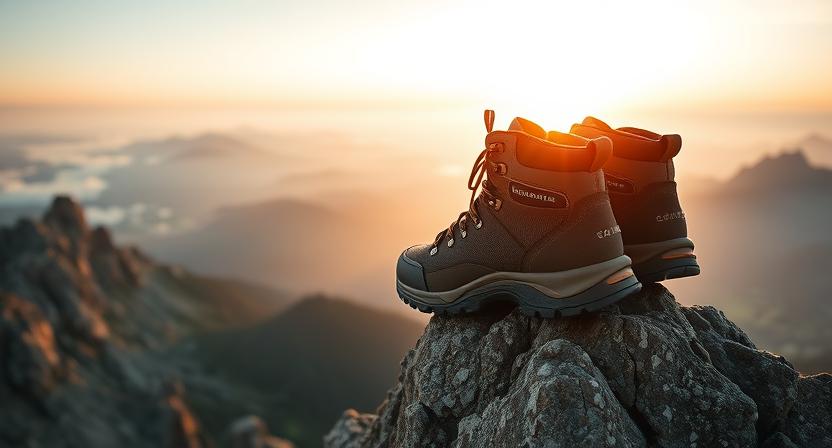
The Topo Athletic Traverse is a lightweight yet rugged hiking shoe built for fast, technical mountain travel. It blends trail-runner agility with all-day hiking stability, making it ideal for those who move quickly across mixed, uneven terrain.
Our Verdict
Best Lightweight Hybrid Hiking Shoe for Technical Trails
The Topo Athletic Traverse proves itself as a lively, protective trail hybrid that keeps you moving when the route tightens and rocks begin to show. Visualize a midmorning scramble where toes splay into a roomy forefoot while a forefoot rock plate dulls the sting of sharp stones; that balance of comfort and protection is the core payoff. The Traverse is a well suited fast-hiking and light fastpacking shoe built to carry you further with confidence. It leans on a responsive, multi density/ZipFoam platform and Vibram MegaGrip rubber to deliver traction and a connected feel, and its roomy, foot shaped toe box tends to reduce hot spots on long outings.
One clear caveat is waterproofing; the Traverse is not a waterproof model so it matters on wet, boggy routes. Best for hikers who want trail-run agility with extra underfoot protection. Buy it.
Specs
- Best For: Hiking, fastpacking, thru hiking and mixed technical trails.
- Weight: Approx. 1.31 lb per pair.
- Upper material: Durable, abrasion resistant woven mesh with reinforced overlays.
- Midsole construction: Multi density / ZipFoam midsole with a forefoot TPU rock plate.
- Waterproof: No
- Fit profile: True to size with a roomy, foot shaped toe box.
- Price: $155
- Overall Rating: 4.1/5 ⭐⭐⭐⭐☆
Pros & Cons
| Pros | Cons |
|---|---|
| Roomy toe box lets toes spread naturally on long miles. | Not waterproof, so it soaks on prolonged wet hikes. |
| Vibram Megagrip outsole supplies reliable traction on slick rock. | Upper may feel less durable than heavy duty backpacking boots. |
| Forefoot rock plate shields against sharp trail debris. | Slightly heavier than lightweight trail runners for fast descents. |
| Balanced ZipFoam midsole feels responsive yet protective. | Narrower sizing reports exist for some users on certain roads and retailers. |
| Gaiter compatible for loose, debris prone terrain. |
Testing Conditions

We evaluated the Topo Athletic Traverse across varied, purpose-driven conditions that mirror real use: slickrock and sandstone slabs, loose gravel and scree, narrow technical singletrack, muddy forest pitches, and multiple creek crossings. Field protocols included a two-day, 46-mile push on the Burr Trail with a sustained 29 lb pack, repeated steep ascents and rocky descents in 45–70°F, and a dedicated five-mile creek sequence to test the closed-cell FKT insole and drainage. Shorter fastpacking loops emphasized agility and turnover to probe the 5 mm drop, while loaded miles evaluated midsole comfort and the forefoot rock plate against sharp debris.
Traction trials used wet slickrock and muddy roots to validate the Vibram Megagrip outsole. Fit checks were run under load to monitor toe-splay, heel lock, and lacing security. We recorded soak times, dry-out intervals, and midsole feel over repeated miles, and compared perceived fatigue against shoe weight of roughly 1 lb 3.2 oz per pair. We alternated light and moderate pack loads and varied sock thickness to observe fit and thermal response, and ran fast and controlled descents to test lacing security so readers get practical, context-specific feedback on when the shoe tends to shine and when a full waterproof option is preferable.
Performance
Fit & Sizing
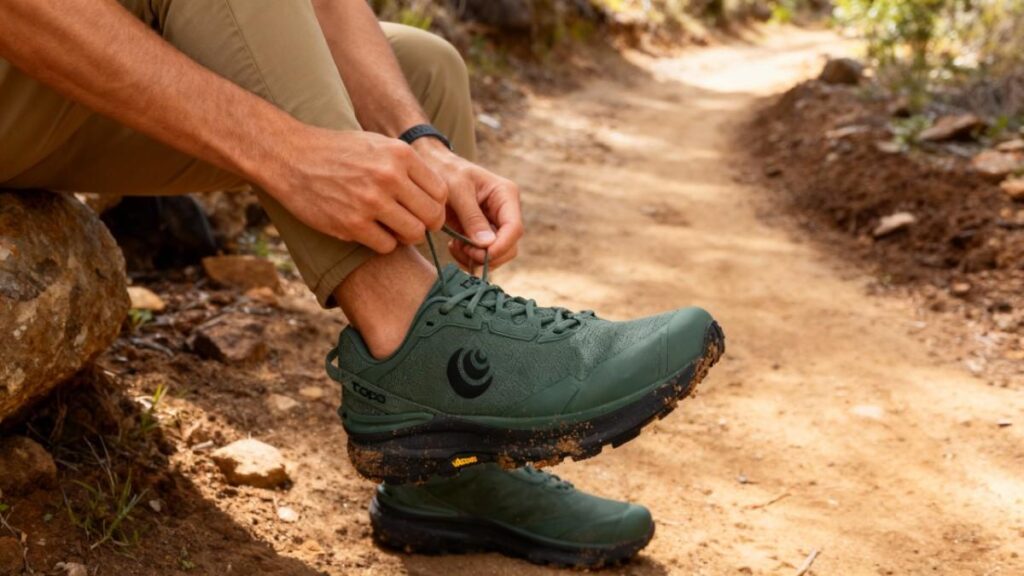
I use and wear men’s US 9 in the Topo Athletic Traverse and found it true to size with the brand’s foot-shaped last that gives extra forefoot room. The toe box allows toes to splay naturally while the midfoot and heel stay secure, so I did not get heel slip on steep downhills. Volume is moderate; the shoe avoids both pinching and a sloppy fit. Break in was short; the mesh upper relaxed after a few hikes. On a 12 mile ridge scramble I felt steady toe comfort and no hotspots. Thin synthetic socks matched the fit well; adding a 3 mm orthotic reduced internal volume and made the shoe feel about a quarter size tighter.
Half sizes are useful; size to the longer foot. The lacing lets you micro adjust the midfoot and a double knot keeps the laces from loosening. Insole swaps fit cleanly and did not create heel lift. Topo’s roomy last and toe shape help hikers who like natural spread while keeping a secure rearfoot. Compared to the Altra Lone Peak 9, the Topo Athletic Traverse offers similar forefoot room but uses a 5 mm drop versus Lone Peak’s zero drop, so the posture and feel differ.
Comfort & Cushioning
The Topo Athletic Traverse uses a ZipFoam multi density midsole that feels balanced between responsive and protective, leaning toward a connected, lively ride rather than maximal plushness. On a 22 mile mixed terrain day my feet stayed steady and I had low soreness by evening, though long rocky descents made the foam feel firmer and less bouncy. Arch support is neutral with mild guidance through the midfoot; the stock FKT closed cell insole sheds water and gives reasonable underfoot comfort. Swapping to a thinner performance orthotic made the shoe feel firmer, while a 3 mm aftermarket foam added padding and reduced perceived impact.
I did not develop hotspots in testing, and the midsole resists quick compression but can lack long-run rebound for heavy ultramarathon pacing. The platform tends to favor hikers and fastpackers who like ground feel with protection rather than runners seeking maximal energy return. The ZipFoam midsole and forefoot rock plate are core features listed by Topo. Compared to the HOKA Kaha 3 GTX, the Topo Athletic Traverse feels firmer and more responsive rather than plush and pillowy.
Support & Stability
The Topo Athletic Traverse offers light stability via a firm multi density midsole and a forefoot rock plate that limits sharp impacts while allowing a fair amount of forefoot flex. The shoe sits relatively close to the ground which helps balance and torsional control for a low top hybrid, but it is not as rigid as true backpacking boots. With a 29 lb daypack on loose scree I felt confident edging and the platform resisted excessive roll, though sustained heavy loads revealed the limits of a low cut shoe. For most hikers I estimate practical pack comfort up to about 30 to 35 lb; beyond that a higher, stiffer boot will feel more secure.
Ankle support is modest due to the low collar, so hikers prone to lateral instability should consider a mid or high top or light braces. Orthotics can add arch control and reduce mild pronation. Topo describes the Traverse as a stable, nimble option built for thru hiking and fastpacking. Compared to the Salomon Quest 4 GTX, the Topo Athletic Traverse is far lighter and more agile but lacks the heavy duty support that the full backpacking boot provides.
Traction & Outsole Performance
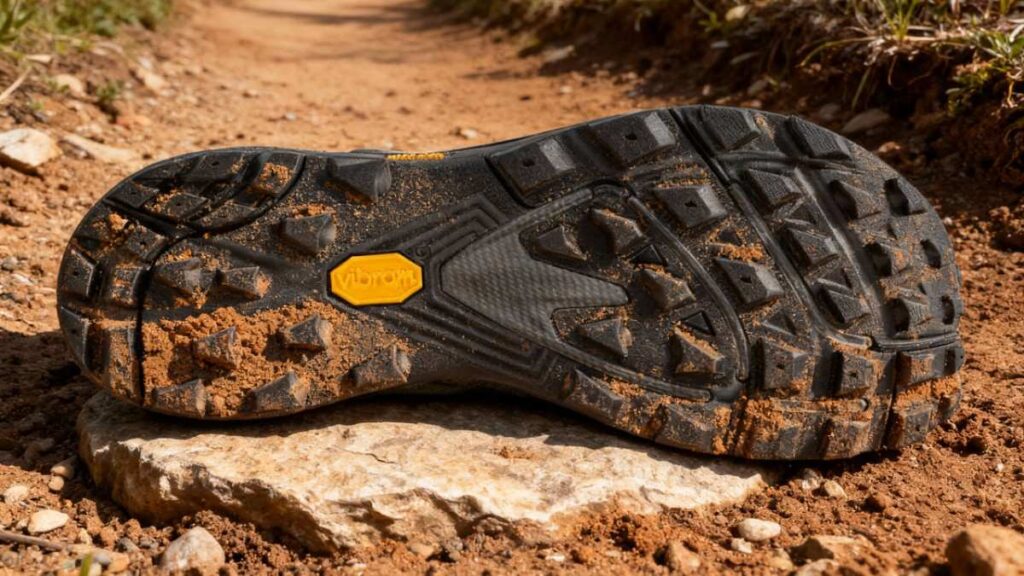
The Topo Athletic Traverse uses a Vibram Megagrip outsole with multidirectional lugs around 4 mm, which delivers confident purchase on rock and damp roots. On wet slickrock at roughly 55°F I could edge without slipping on mossy patches, and the lugs bit well on loose gravel and compact dirt. The tread clears mud reasonably quickly on rolling climbs, and after a 46 mile two day push the lugs showed minimal rounding and no sole delamination. The Megagrip compound balances stickiness and longevity, so traction holds up without excessive wear on abrasive surfaces.
Heavy clay will pack more than loose loam, but quick cadence and brief cleaning restore bite. During steep descents the pattern gives small edges that reduce sudden slides, which is reassuring when you need controlled braking. For hikers who want sure footing while moving fast, the outsole is a solid asset. Compared to the Altra Lone Peak 9, the Topo Athletic Traverse feels a touch more aggressive for scrambling while the Lone Peak provides a broader platform for standing on rock.
Protection
The Topo Athletic Traverse pairs a molded forefoot rock plate with a modest toe bumper and reinforced rand to protect against rocks and trail debris. Upper overlays add abrasion resistance without making the shoe stiff. In a scramble I stepped onto a jagged sandstone edge and felt a dull thud through the midsole but no sharp pain, which showed the plate absorbed the impact. The toe bumper scuffed but my toes stayed comfortable. Rand coverage and the close weave mesh reduce seam rub and limit debris entry; the tongue gusset helps keep out grit and small stones.
Gaiter compatibility adds an extra barrier for dusty routes. Over rocky descents the plate cuts down sharp pressure points and helps prevent toe jamming on step downs. Stitching held up and the upper showed only light scuffs after long days. Compared to the Salomon X Ultra 4 GTX, the Topo Athletic Traverse gives strong underfoot shielding while remaining lighter and nimbler, though the Salomon has a more robust toecap and sidewall for heavier pounding.
Waterproofing & Breathability
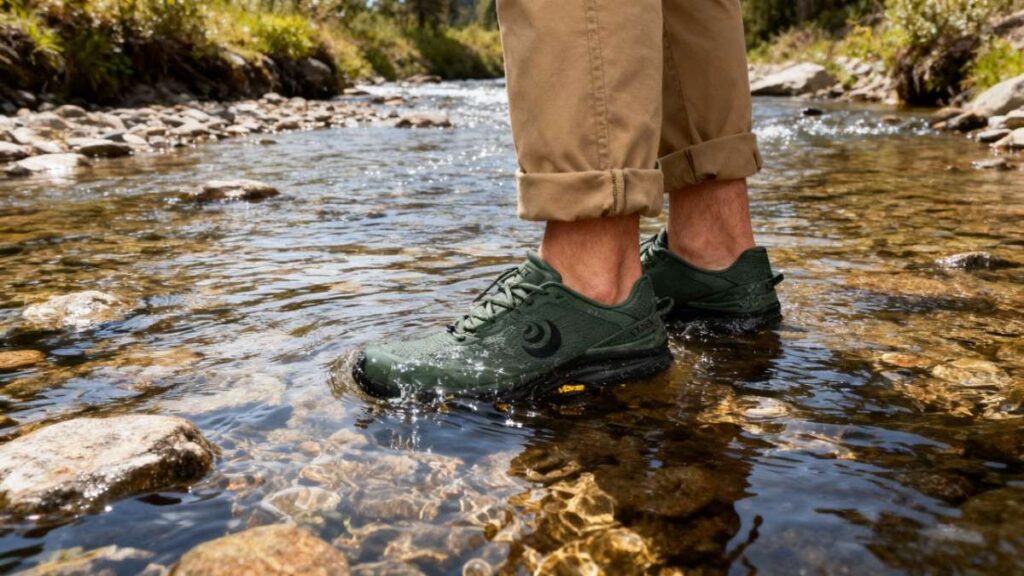
The Topo Athletic Traverse is not a waterproof Gore Tex model; it uses a breathable abrasion resistant mesh and a closed cell FKT insole that resists water and drains quickly when needed. That means the shoe will not keep out deep standing water or long, soaking rain, but it handles short creek crossings better than many plain mesh shoes. In a five mile creek sequence my socks stayed only slightly damp at the toe and the FKT insole expelled residual moisture within about fifteen minutes of hiking in direct sun, which kept comfort high for the remainder of the day.
Breathability is strong on warm climbs and vents heat well during sustained efforts. If you need full wet weather protection, pick a Gore Tex boot, but expect heavier weight and less airflow. Compared to a Gore Tex hiker like the HOKA Kaha 3 GTX, the Topo Athletic Traverse dries faster and breathes better but will let water in on long wet stretches. Wearing quick dry socks helps speed dry time and limit damp discomfort. This setup favors fastpackers who cross streams and value rapid drying.
Durability & Build Quality
Construction on the Topo Athletic Traverse is purposeful for a light trail hybrid. The abrasion resistant woven mesh and reinforced overlays held with only light scuffs after roughly 46 miles of mixed terrain testing, and the Vibram Megagrip outsole retained lug shape without delamination. Stitching around the toe and heel stayed intact and lace eyelets showed no stress. If you run long miles over coarse talus or volcanic rock you will accelerate outsole and upper wear, but the Vibram compound slows that compared with lower grade rubbers.
Basic care—rinsing grit, drying at room temperature, and occasional seam treatment—extends life. For a long distance hiker who uses mixed trails, a conservative lifespan estimate is about 500 to 700 miles before outsole rounding or cushioning fade become noticeable, though light users may see longer service. Compared to the Altra Lone Peak 9, the Topo Athletic Traverse is lighter while the Lone Peak’s ripstop upper can outlast the Traverse on highly abrasive routes.
Performance Table
| Metric | Result/Finding | Remarks |
|---|---|---|
| Fit & Sizing | True to size (Men’s US 9 tested) | Roomy toe box; secure heel; short 1–2 hike break-in period |
| Weight | ~10.6 oz per shoe / 1 lb 3.2 oz per pair | Feels light for a hybrid hiker-runner |
| Cushioning | Moderate-firm ZipFoam midsole | Comfortable up to 20–25 mile days; less rebound on long rocky descents |
| Support Threshold | Stable up to ≈ 30–35 lb pack load | Low-cut collar gives minimal ankle support |
| Traction | Vibram Megagrip outsole, 4 mm lugs | Excellent grip on wet slickrock and muddy roots |
| Water Management | Non-waterproof mesh; drains in ~15 min after creek crossing | FKT closed-cell insole sheds water fast |
| Drying Time | 10–15 min in direct sun after full soak | Socks stayed only slightly damp at toe |
| Durability (Tested Distance) | ≈ 46 miles field tested | Minimal outsole wear; stitching intact |
| Comfort Rating | 8.5 / 10 | Neutral arch; mild firmness under heavy load |
| Overall Field Rating | ⭐ 4.1 / 5 (aggregated) | Reliable hybrid for fastpacking and mixed-terrain hiking |
Downsides

The Topo Athletic Traverse is a capable shoe, but it carries real trade offs you should know. In wet, sustained conditions the Traverse tends to let water into the upper because it is not a waterproof model, and I felt damp toes after longer stream crossings if the weather turned. The midsole leans toward a firmer, more connected ride, which helps stability but can feel tiring on long, rocky descents; on a long downhill I noticed more foot vibration and less rebound than plush alternatives. The low-cut collar gives nimble mobility but limits ankle protection under heavy loads, so the Traverse likely will not replace a true backpacking boot for 40+ pound packs.
Some users report slight variation in width between sizes, so you may need to size carefully or try a half size. Lacing can creep if not double knotted, and while the abrasion resistant mesh is light it may not match heavyweight boots on very abrasive terrain. Finally, the closed-cell FKT insole aids drainage but also reduces airflow directly underfoot, which can make the interior feel warmer during long, hot climbs.
Best Alternatives for Topo Athletic Traverse
HOKA Speedgoat 6

The HOKA Speedgoat 6 leans toward maximum cushion and aggressive trail traction while the Topo Athletic Traverse favors ground feel, toe-room, and fastpacking drainage. The Speedgoat 6 uses a higher stack CMEVA platform with a 5 mm drop and a beefy Vibram Megagrip outsole that delivers softer landings and pronounced lug bite on technical descents, making it feel more plush on long downhills. The Topo Athletic Traverse relies on a multi-density ZipFoam midsole, a forefoot rock plate, a foot-shaped roomy toe box, and quick-drain FKT insole that together tend to offer better toe splay, protection from sharp debris, and faster drying after creek crossings.
The trade off is comfort versus connection: Speedgoat 6 sacrifices some ground feel for cushioning and longer fatigue control, while the Topo Athletic Traverse keeps you closer to the trail with lighter structure and better water management. Choose the HOKA Speedgoat 6 if you want maximum cushion and long-day shock absorption; buy the Topo Athletic Traverse if you prioritize nimble fastpacking and quick drying on wet routes.
Salomon Sense Ride 5
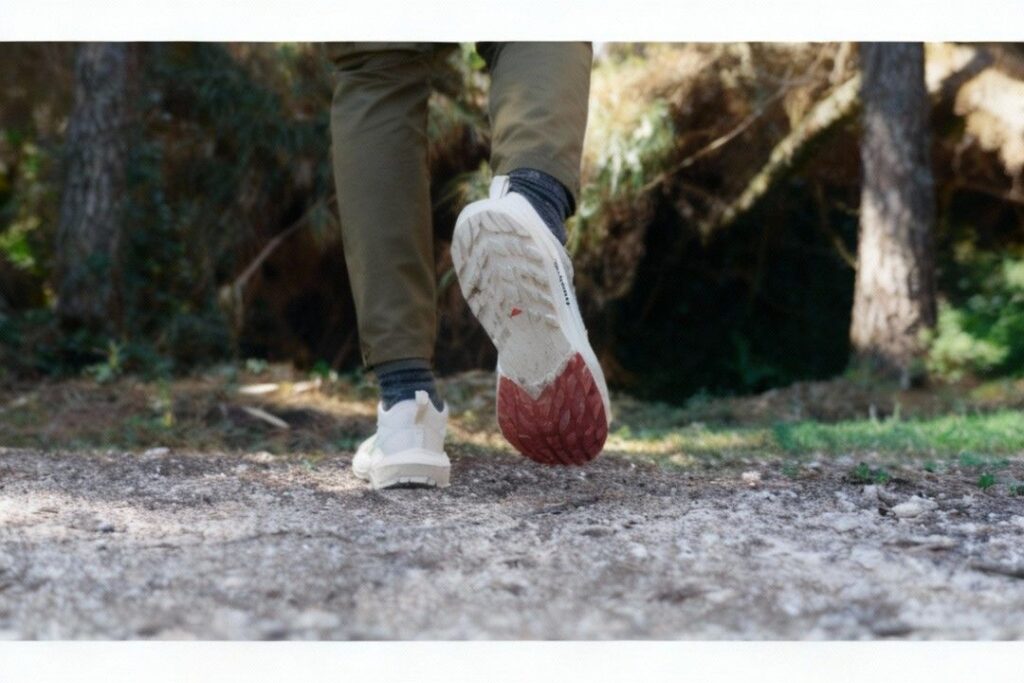
The Salomon Sense Ride 5 leans toward an everyday trail trainer with a balanced EnergyCell+ midsole and Contagrip outsole, while the Topo Athletic Traverse leans toward fastpacking and mixed-terrain protection with a rock plate and drainage features. The Sense Ride 5 offers a moderate stack and tuned cushioning that tends to smooth rolling miles and provides predictable, compliant landings; its Contagrip rubber is reliable on mixed trails. The Topo Athletic Traverse answers with a roomier anatomical last, a forefoot rock plate for blunt impact protection, and a closed-cell FKT insole that sheds water quickly, which makes it better for stream crossings and long hikes where toe-space matters.
The Sense Ride 5 tends to be more cushioned and agile for daily runs, while the Topo Athletic Traverse is better suited to long, mixed-terrain treks that need protection and quick drying. Buy the Salomon Sense Ride 5 if you want a versatile trail daily trainer; choose the Topo Athletic Traverse if you need toe room, protection, and faster water management.
Comparison of Best Alternatives
| Name | Weight (lbs per pair) | Waterproof | Best For | Price |
|---|---|---|---|---|
| Topo Athletic Traverse | 1.33 lb | No | Thru-hiking, fastpacking, mixed technical trails. | $155 |
| HOKA Speedgoat 6 | 1.43 lb | No for standard | Aggressive trail running and technical fastpacking; riders who want more cushion and big-lug traction. | $155 |
| Salomon Sense Ride 5 | 1.25 lb | No for standard | Daily trail runs and mixed-terrain miles; versatile road-to-trail runners. | ~$150 |
Who Should Buy/Avoid Topo Athletic Traverse

You Should Buy if
- You want a roomy, foot shaped toe box that likely reduces hot spots on long miles.
- You need quick drying after creek crossings and value fast water shedding.
- You move fast on mixed, technical trails and prefer a lower, more connected platform.
- You want solid traction and a protective forefoot rock plate without the weight of a boot.
You Should Avoid if
- You need full waterproofing for wet seasons or long, soaking river travel.
- You plan to carry very heavy loads over sustained days above ~35 lb.
- You prefer plush, pillow like cushioning for long technical descents.
- You require significant ankle support or glide-stable frames for rolling ankles.
FAQs
Does the Topo Athletic Traverse run true to size?
Yes. It generally fits true to size with a roomy forefoot; size to your longer foot and consider a half size if between sizes.
Is the Topo Athletic Traverse waterproof?
No. It is not a Gore Tex model; it uses a closed cell FKT insole that sheds water quickly but will not keep out prolonged soaking.
Can I use the Topo Athletic Traverse for thru-hiking or fastpacking?
Yes. It tends to be well suited to fastpacking and thru-hiking with moderate loads up to about 30–35 lb.
How does traction perform on wet rock and muddy trails?
Traction is strong thanks to Vibram Megagrip and multidirectional lugs; it grips wet rock well and tends to shed mud reasonably on rolling terrain.
Are insoles or orthotics recommended?
Swapping to a thin orthotic can improve arch support and reduce volume; thicker inserts will make the fit feel about a quarter size tighter.
Ethan Marlowe is an experienced hiker and outdoor gear specialist based in Colorado. With over 7 years of hands-on experience trekking through the Rockies, Pacific Northwest, and East Coast trails, he delivers practical advice, expert gear reviews, and survival insights. His goal is to help hikers of all levels make smarter decisions on and off the trail.


